基于模型学习的多天线多频定位信道映射
IF 8.7
1区 工程技术
Q1 ENGINEERING, ELECTRICAL & ELECTRONIC
IEEE Journal of Selected Topics in Signal Processing
Pub Date : 2025-03-13
DOI:10.1109/JSTSP.2025.3549952
引用次数: 0
摘要
对传播信道的多年研究表明,位置与相关的通信信道响应之间存在密切关系。因此,可以设想使用神经网络来学习位置到信道的映射。隐式神经表征(INR)文献表明,经典的神经结构倾向于学习低频内容,使得位置到通道映射学习成为一个非平凡的问题。事实上,众所周知,这种映射是一个随位置迅速变化的函数,按波长的顺序变化。本文利用基于模型的机器学习范式从传播通道模型中派生出特定问题的神经体系结构。由此产生的结构有效地克服了光谱偏差问题。它只学习低频稀疏校正项,激活高频成分字典。在真实的合成数据上对比经典的INR体系结构进行了评估,显示出更好的准确性。它的映射学习性能是基于近似通道模型来解释的,突出了基于模型的机器学习范式的可解释性。本文章由计算机程序翻译,如有差异,请以英文原文为准。
Model-Based Learning for Multi-Antenna Multi-Frequency Location-to-Channel Mapping
Years of study of the propagation channel showed a close relation between a location and the associated communication channel response. The use of a neural network to learn the location-to-channel mapping can therefore be envisioned. The Implicit Neural Representation (INR) literature showed that classical neural architecture are biased towards learning low-frequency content, making the location-to-channel mapping learning a non-trivial problem. Indeed, it is well known that this mapping is a function rapidly varying with the location, on the order of the wavelength. This paper leverages the model-based machine learning paradigm to derive a problem-specific neural architecture from a propagation channel model. The resulting architecture efficiently overcomes the spectral-bias issue. It only learns low-frequency sparse correction terms activating a dictionary of high-frequency components. The proposed architecture is evaluated against classical INR architectures on realistic synthetic data, showing much better accuracy. Its mapping learning performance is explained based on the approximated channel model, highlighting the explainability of the model-based machine learning paradigm.
求助全文
通过发布文献求助,成功后即可免费获取论文全文。
去求助
来源期刊

IEEE Journal of Selected Topics in Signal Processing
工程技术-工程:电子与电气
CiteScore
19.00
自引率
1.30%
发文量
135
审稿时长
3 months
期刊介绍:
The IEEE Journal of Selected Topics in Signal Processing (JSTSP) focuses on the Field of Interest of the IEEE Signal Processing Society, which encompasses the theory and application of various signal processing techniques. These techniques include filtering, coding, transmitting, estimating, detecting, analyzing, recognizing, synthesizing, recording, and reproducing signals using digital or analog devices. The term "signal" covers a wide range of data types, including audio, video, speech, image, communication, geophysical, sonar, radar, medical, musical, and others.
The journal format allows for in-depth exploration of signal processing topics, enabling the Society to cover both established and emerging areas. This includes interdisciplinary fields such as biomedical engineering and language processing, as well as areas not traditionally associated with engineering.
 求助内容:
求助内容: 应助结果提醒方式:
应助结果提醒方式:


